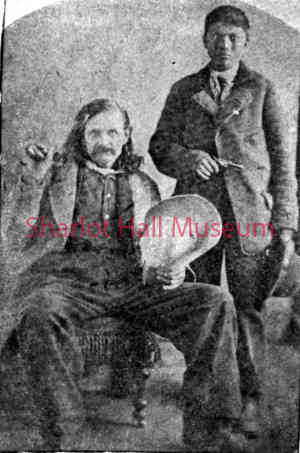Jack Swilling
details
Unknown Unknown po0874p.jpg PO-0874 B&W 1700-0874-0000 po0874p Copy Negative 3x5 Historic Photographs 1875 Reproduction requires permission. Digital images property of SHM Library & ArchivesDescription
Jack Swilling with an Apache boy
Jack William Swilling (b. April 1, 1830 - d. August 12, 1878) was born at Red House Plantation in Anderson, South Carolina to George and Margaret (Farrar) Swilling. In 1844, the family moved to Georgia. In 1847, Jack enlisted in a mounted battalion of Georgia volunteers for service during the Mexican–American War.
In 1852, Jack married Mary Jane Gray in Wetumpka, Alabama, and their daughter Elizabeth was born a year later.
Swilling wrote in 1854 that he suffered serious injuries—a broken skull and a bullet lodged in his back—in unstated circumstances. Those injuries plagued him for the rest of his life and led to a dependency on drugs and alcohol. Between 1857 and his death in 1878, Swilling was involved in a number of pursuits. In the summer of 1857, he apparently joined the Leach Wagon Road Company at Fort Smith, Arkansas as a teamster, probably staying with the slow-moving oxen-drawn wagon train until its arrival a year later at Mesilla, New Mexico Territory. Swilling next moved to southern California, where he joined in a gold rush near Los Angeles.
Swilling came to Arizona for the Gila City gold rush, where he also worked for the Butterfield Overland Mail Company. He was elected captain of the Gila Rangers militia company formed to provide protection from Apache stock raids.
When the Union Army withdrew from the New Mexico Territory at the beginning of the Civil War, the men of Pinos Altos formed a militia company they named the Arizona Guards for defense against Apache attacks.
Following the Union's capture of Tucson in May 1862, Swilling's company retreated and he became a civilian employee of the United States Army, first as a dispatch rider and later as a scout in an anti-Apache campaign.
Near the end of that employment, he encountered the Joseph Walker exploratory party near Pinos Altos. He convinced Joseph Walker and his group that there was gold in the central highlands of the new Arizona Territory and guided them to where the first Yavapai County mining district was formed - just a few miles south of present-day Prescott, on May 10, 1863.
Swilling left the Walker party and joined up with the exploratory party of Pauline Weaver and Abraham Harlow Peeples, which arrived in the area shortly after the Walker group. He made a small fortune from the unusual surface gold mine at Rich Hill between Wickenburg and Prescott. News of his successes spread eastward when two gold samples from Swilling’s claim, sent to General James Carleton, were forwarded for presentation to President Abraham Lincoln.
Next, Swilling spent time in Tucson, but returned to Yavapai County where he prospected, owned gold mines and gold milling operations, farmed and was a mail contractor. He married a young Mexican woman of Spanish heritage named Trinidad Mejia Escalante (b. 1847 - d. 1925) on April 11, 1864. Over the next fourteen years they had seven biological children, five girls and two boys, and adopted two Apache orphans.
On November 16, 1867, Jack Swilling formed a canal company, the Swilling Irrigating and Canal Company, which would open the Salt River Valley to farming. Soon after, Swilling started construction of the first modern-era irrigation canals in the Salt River Valley and started the small farming community of Phoenix. He claimed a quarter section and built a nine-room home that became a local showplace.
Once Phoenix was well-established, he lost interest and moved his growing family back to central Arizona where he mined, farmed and ranched in the small mining community of Gillett, around the area of Black Canyon City, Arizona.
However, by this time his health was failing, and his drinking had become a problem. His wife suggested that he go on a trip to recover and rebury the remains of their old friend, Colonel Jacob Snively. While Swilling and two companions were on this journey, three hooded men robbed a stagecoach near Wickenburg. Their description matched that of Swilling and his companions and they became suspects in the robbery. Swilling was jailed in the Yuma Federal Jail and died in his cell August 12, 1878.
He is buried in the Yuma Pioneer Cemetery, Yuma, Arizona, but the location of his grave is unknown.
Purchase
To purchase this image please click on the NOTIFY US button and we will contact you with details
The process for online purchase of usage rights to this digital image is under development. To order this image, CLICK HERE to send an email request for details. Refer to the ‘Usage Terms & Conditions’ page for specific information. A signed “Permission for Use” contract must be completed and returned. Written permission from Sharlot Hall Museum is required to publish, display, or reproduce in any form whatsoever, including all types of electronic media including, but not limited to online sources, websites, Facebook Twitter, or eBooks. Digital files of images, text, sound or audio/visual recordings, or moving images remain the property of Sharlot Hall Museum, and may not be copied, modified, redistributed, resold nor deposited with another institution. Sharlot Hall Museum reserves the right to refuse reproduction of any of its materials, and to impose such conditions as it may deem appropriate. For certain scenarios, the price for personal usage of the digital content is minimal; CLICK HERE to download the specific form for personal usage. For additional information, contact the Museum Library & Archives at 928-445-3122 ext. 14 or email: orderdesk@sharlot.org.




